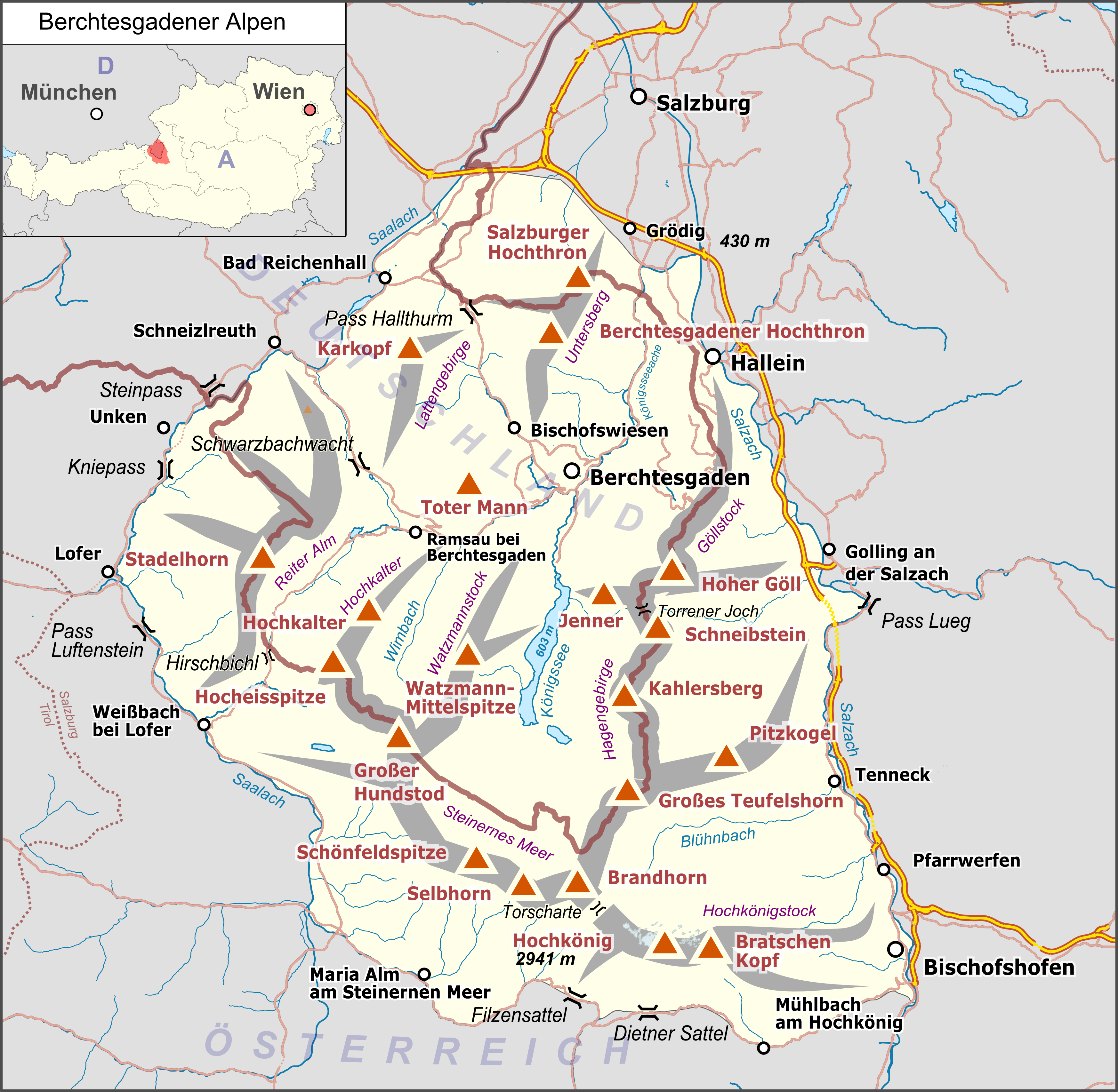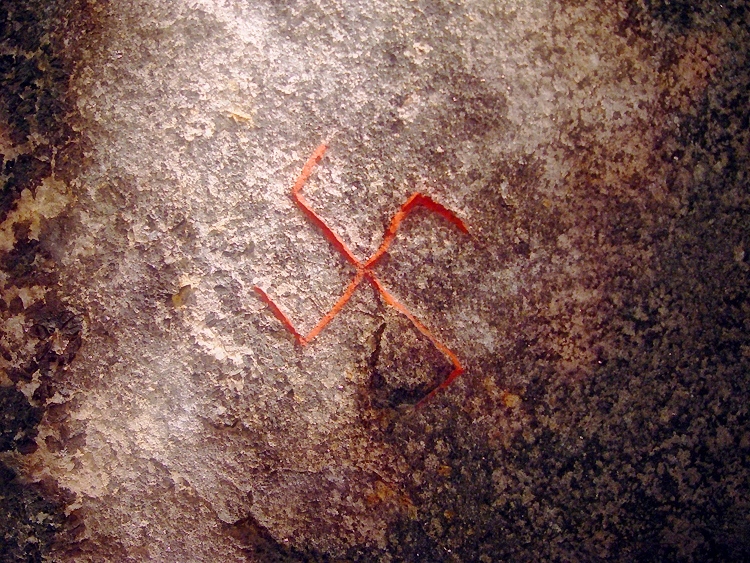|
Barmsteine
The Barmsteine are two rock towers, 841 and 851 metres above Normalnull, sea level, in the northernmost part of the Hasel Mountains in the Bavarian Alps. They rise above the Austrian town of Hallein, and lie on the border between Salzburg (state), Salzburger Land in Austria and Berchtesgadener Land in Germany. Geology Geologically, the pinnacles have given their name to the so-called Barmstein limestone (''Barmsteinkalk''), a turbidite sequence which is part of the Oberalm Formation in the Upper Jurassic rock layer. File:Barmstoa01.jpg, The Great Barmstein, right: Salzburg Land, left: Berchtesgaden Land File:Felseinlagerung_am_barmstoa.jpg, A rock insert on the Small Barmstein Climbing and walking Both rock pinnacles are a popular destination, especially for climbing, climbers because they are lit by the sun until late in the evening and are easy to get to. The climbing grade of the Small Barmstein is II to III, the Great Barmstein is significantly harder. In addition ... [...More Info...] [...Related Items...] OR: [Wikipedia] [Google] [Baidu] |
Berchtesgaden Alps
The Berchtesgaden Alps (, ) are a mountain range of the Northern Limestone Alps, named after the market town of Berchtesgaden located in the centre. It is crossed by the Austria–Germany border: the central part belongs to the Berchtesgadener Land district of southeastern Bavaria, Germany, while the adjacent area in the north, east and south is part of the Austrian state of Salzburg (state), Salzburg (''Salzburger Land''). Geography Mountains and lakes While the highest mountain of the Berchtesgaden Alps is the Hochkönig () located in the Austrian part, the best known peak is the Watzmann massif, the third-highest mountain of Germany at . The range also comprises the Obersalzberg slope east of Berchtesgaden, known for the former Berghof (residence), Berghof residence of Adolf Hitler. The picturesque heart is formed by the glacial Königssee lake with the famous St. Bartholomew's Church, Berchtesgaden, St. Bartholomew's pilgrimage church and the smaller Obersee (Königssee), O ... [...More Info...] [...Related Items...] OR: [Wikipedia] [Google] [Baidu] |
Climbing
Climbing is the activity of using one's hands, feet, or other parts of the body to ascend a steep topographical object that can range from the world's tallest mountains (e.g. the eight thousanders) to small boulders. Climbing is done for locomotion, sporting recreation, for competition, and is also done in trades that rely on ascension, such as construction and military operations. Climbing is done indoors and outdoors, on natural surfaces (e.g. rock climbing and ice climbing), and on artificial surfaces (e.g. climbing walls and climbing gyms). The sport of climbing evolved by climbers making first ascents of new types of climbing routes, using new climbing techniques, at ever-increasing grades of difficulty, with ever-improving pieces of climbing equipment. Guides and guidebooks were an important element in developing the popularity of the sport in the natural environment. Early pioneers included Walter Bonatti, Riccardo Cassin, Hermann Buhl, and Gaston Rébuffat, wh ... [...More Info...] [...Related Items...] OR: [Wikipedia] [Google] [Baidu] |
Mountains Of Salzburg (federal State)
A mountain is an elevated portion of the Earth's crust, generally with steep sides that show significant exposed bedrock. Although definitions vary, a mountain may differ from a plateau in having a limited summit area, and is usually higher than a hill, typically rising at least above the surrounding land. A few mountains are isolated summits, but most occur in mountain ranges. Mountains are formed through tectonic forces, erosion, or volcanism, which act on time scales of up to tens of millions of years. Once mountain building ceases, mountains are slowly leveled through the action of weathering, through slumping and other forms of mass wasting, as well as through erosion by rivers and glaciers. High elevations on mountains produce colder climates than at sea level at similar latitude. These colder climates strongly affect the ecosystems of mountains: different elevations have different plants and animals. Because of the less hospitable terrain and climate, mountains te ... [...More Info...] [...Related Items...] OR: [Wikipedia] [Google] [Baidu] |
Mountains Of Bavaria
A mountain is an elevated portion of the Earth's crust, generally with steep sides that show significant exposed bedrock. Although definitions vary, a mountain may differ from a plateau in having a limited summit area, and is usually higher than a hill, typically rising at least above the surrounding land. A few mountains are isolated summits, but most occur in mountain ranges. Mountains are formed through tectonic forces, erosion, or volcanism, which act on time scales of up to tens of millions of years. Once mountain building ceases, mountains are slowly leveled through the action of weathering, through slumping and other forms of mass wasting, as well as through erosion by rivers and glaciers. High elevations on mountains produce colder climates than at sea level at similar latitude. These colder climates strongly affect the ecosystems of mountains: different elevations have different plants and animals. Because of the less hospitable terrain and climate, mountains ... [...More Info...] [...Related Items...] OR: [Wikipedia] [Google] [Baidu] |
Mountains Of The Alps
This page tabulates only the most prominent mountains of the Alps, selected for having a topographic prominence of ''at least'' , all exceeding in height. Although the list contains 537 summits, some significant alpine mountains are necessarily excluded for failing to meet the stringent prominence criterion. The list of these most prominent mountains is continued down to 2500 m elevation at List of prominent mountains of the Alps (2500–2999 m) and down to 2000 m elevation on List of prominent mountains of the Alps (2000–2499 m). All such mountains are located in France, Italy, Switzerland, Liechtenstein, Austria, Germany or Slovenia, even in some lower regions. Together, these lists include all 44 ultra-prominent peaks of the Alps, with 19 ultras over 3000m on this page. For a definitive list of all 82 of the highest peaks of the Alps, as identified by the International Climbing and Mountaineering Federation (UIAA), and often referred to as the 'Alpine four-thousanders' ... [...More Info...] [...Related Items...] OR: [Wikipedia] [Google] [Baidu] |
Anschluss
The (, or , ), also known as the (, ), was the annexation of the Federal State of Austria into Nazi Germany on 12 March 1938. The idea of an (a united Austria and Germany that would form a "German Question, Greater Germany") arose after the unification of Germany, 1871 unification of Germany excluded Austria and the German Austrians from the Prussian-dominated German Empire. It gained support after the Austria-Hungary, Austro-Hungarian Empire fell in 1918. The new Republic of German-Austria attempted to form a union with Germany, but the 1919 Treaty of Saint-Germain-en-Laye (1919), Treaty of Saint Germain and Treaty of Versailles forbade both the union and the continued use of the name "German-Austria" (); they also stripped Austria of some of its territories, such as the Sudetenland. This left Austria without most of the territories it had ruled for centuries and amid economic crisis. By the 1920s, the proposal had strong support in both Austria and Germany, particularly ... [...More Info...] [...Related Items...] OR: [Wikipedia] [Google] [Baidu] |
Swastika
The swastika (卐 or 卍, ) is a symbol used in various Eurasian religions and cultures, as well as a few Indigenous peoples of Africa, African and Indigenous peoples of the Americas, American cultures. In the Western world, it is widely recognized as a symbol of the German Nazi Party who Cultural appropriation, appropriated it for their party insignia starting in the early 20th century. The appropriation continues with its use by Neo-Nazism, neo-Nazis around the world. The swastika was and continues to be used as a symbol of divinity and spirituality in Indian religions, including Hinduism, Buddhism, and Jainism. It generally takes the form of a cross, the arms of which are of equal length and perpendicular to the adjacent arms, each bent midway at a right angle. The word ''swastika'' comes from , meaning 'conducive to well-being'. In Hinduism, the right-facing symbol (clockwise) () is called , symbolizing ('sun'), prosperity and good luck, while the left-facing symbol ... [...More Info...] [...Related Items...] OR: [Wikipedia] [Google] [Baidu] |
Nazi Era
Nazi Germany, officially known as the German Reich and later the Greater German Reich, was the German state between 1933 and 1945, when Adolf Hitler and the Nazi Party controlled the country, transforming it into a totalitarian dictatorship. The Third Reich, meaning "Third Realm" or "Third Empire", referred to the Nazi claim that Nazi Germany was the successor to the earlier Holy Roman Empire (800–1806) and German Empire (1871–1918). The Third Reich, which the Nazis referred to as the Thousand-Year Reich, ended in May 1945, after 12 years, when the Allies defeated Germany and entered the capital, Berlin, ending World War II in Europe. After Hitler was appointed Chancellor of Germany in 1933, the Nazi Party began to eliminate political opposition and consolidate power. A 1934 German referendum confirmed Hitler as sole ''Führer'' (leader). Power was centralised in Hitler's person, and his word became the highest law. The government was not a coordinated, cooperat ... [...More Info...] [...Related Items...] OR: [Wikipedia] [Google] [Baidu] |
Gerald Lehner (journalist)
Gerald Lehner (born 12 November 1963) is an Austrian journalist and author. Born in Bad Gastein,https://rss.com/podcasts/thebotstiberpodcast/1389563/ Lehner studied political science in Salzburg. Since 1986 he has been working for ORF (Austrian broadcasting service). He wrote articles for the magazines Profil, Die Zeit and Der Spiegel, as well as for the daily newspaper Der Standard. He has reported from Kurdistan, the Himalayas and the Siberian Arctic. He realized his passion as an alpinist while a technician and teacher for the development aid organization " Öko Himal" in Nepal. Publications *''Die Biographie des Philosophen und Ökonomen Leopold Kohr. Träger des Alternativen Nobelpreises.'' Franz Deuticke Verlag, Wien 1994. *'' Egon Ranshofen-Wertheimer und Leopold Kohr. Mit der Washington Post gegen die Nazis''. In: Dokumentationsarchiv des österreichischen Widerstandes. Jahrbuch 1995. *''Zwischen Hitler und Himalaya The Himalayas, or Himalaya ( ), is a mountai ... [...More Info...] [...Related Items...] OR: [Wikipedia] [Google] [Baidu] |
Ruine Thürndl
Ruine may refer to: *Alter Der Ruine, a power noise group from Tucson, Arizona *La Grande Ruine (3,765 m), a mountain in the French Alps, in the Massif des Écrins *Of Ruine or Some Blazing Starre, an album by English band Current 93 A number of castles in Austria and Germany are designated "Ruine": *Ruine Diepoldsburg, a castle in Baden-Wuerttemberg *Ruine Hauenstein, a castle in Styria, Austria *Ruine Henneberg, a castle in Styria, Austria * Ruine Hohenwang, a castle in Styria, Austria *Ruine Kalsberg, a castle in Styria, Austria *Ruine Katsch, a castle in Styria, Austria *Ruine Klöch, a castle in Styria, Austria *Ruine Liechtenstein, a castle in Styria, Austria *Ruine Ligist, a castle in Styria, Austria *Ruine Neudeck, a castle in Styria, Austria *Ruine Neu-Leonroth, a castle in Styria, Austria *Ruine Nollig, a ruined castle above the village of Lorch in Hesse, Germany *Ruine Offenburg, a castle in Styria, Austria *Ruine Pernegg, a castle in Styria, Austria *Ruine Pflinds ... [...More Info...] [...Related Items...] OR: [Wikipedia] [Google] [Baidu] |
Bouldering
Bouldering is a form of rock climbing that is performed on small rock formations or Climbing wall, artificial rock walls without the use of ropes or Climbing harness, harnesses. While bouldering can be done without any equipment, most climbers use climbing shoes to help secure footholds, Magnesium carbonate, chalk to keep their hands dry and to provide a firmer grip, and bouldering mats to prevent injuries from falls. Unlike free solo climbing, which is also performed without ropes, bouldering problems (the sequence of moves that a climber performs to complete the climb) are usually less than tall. Traverses, which are a form of boulder problem, require the climber to climb horizontally from one end to another. Indoor climbing, Artificial climbing walls allow boulderers to climb indoors in areas without natural boulders. Competition climbing, Bouldering competitions take place in both indoor and outdoor settings. The sport was originally a method of training for roped climbs a ... [...More Info...] [...Related Items...] OR: [Wikipedia] [Google] [Baidu] |







